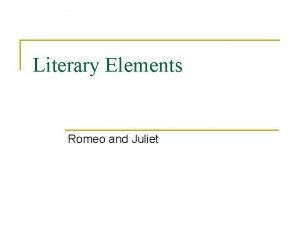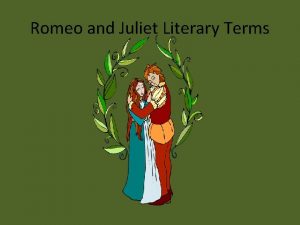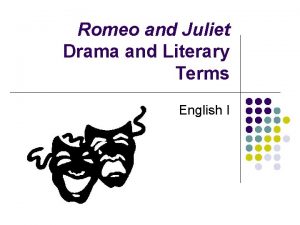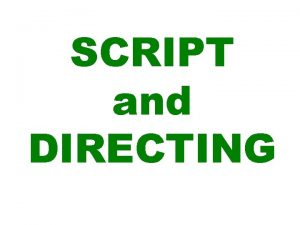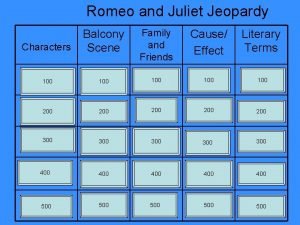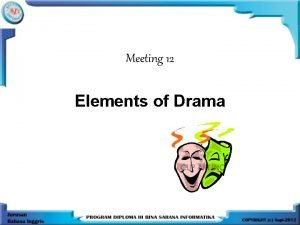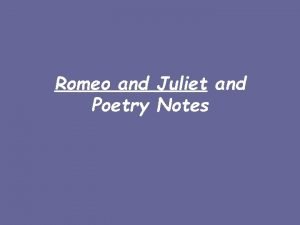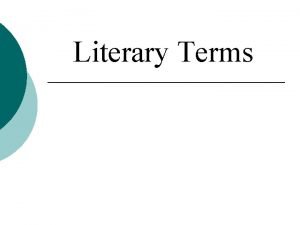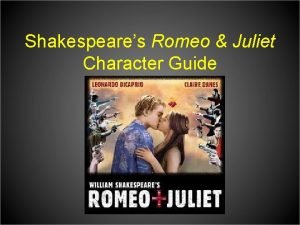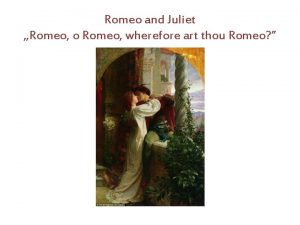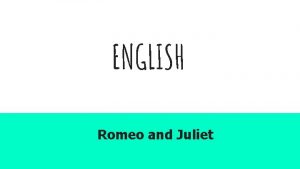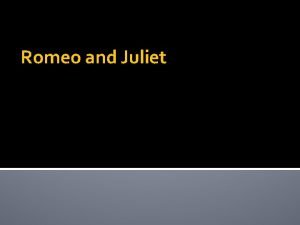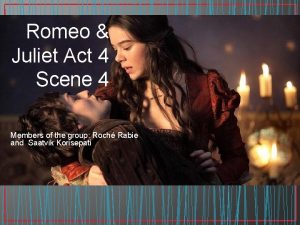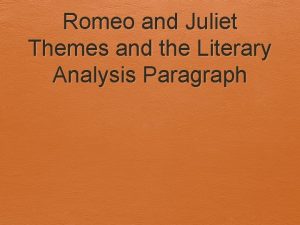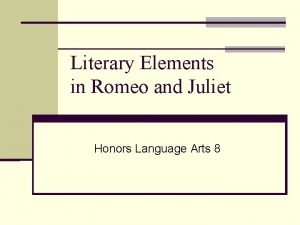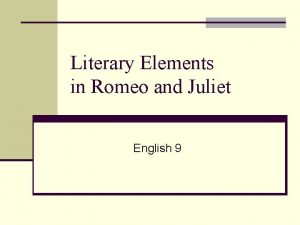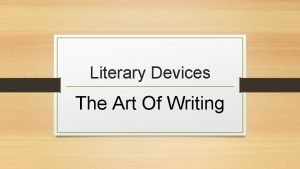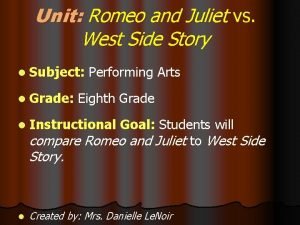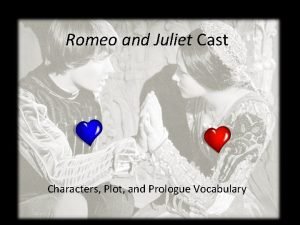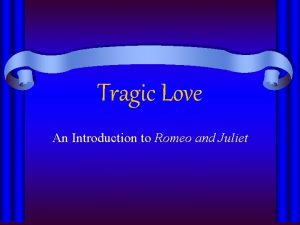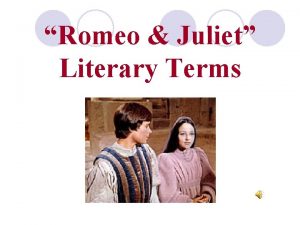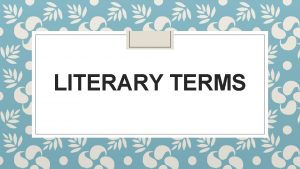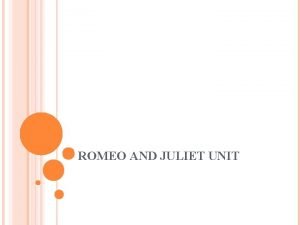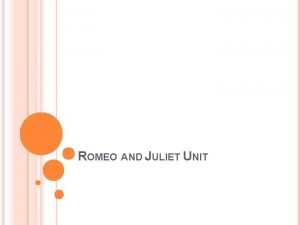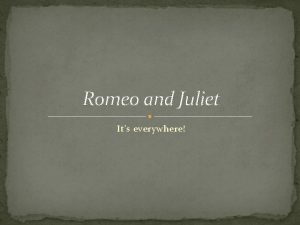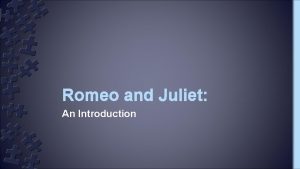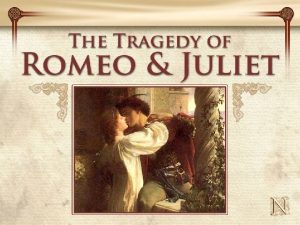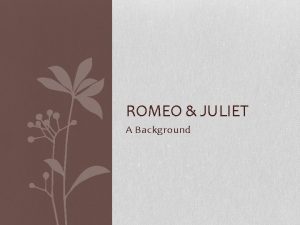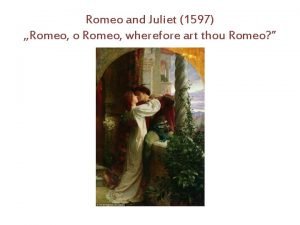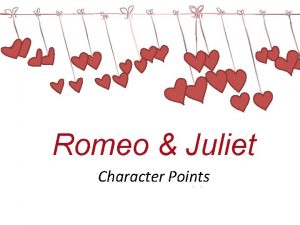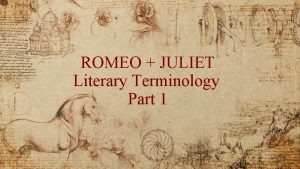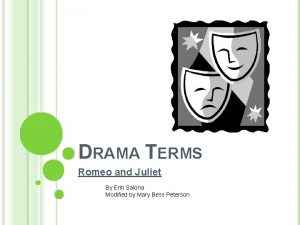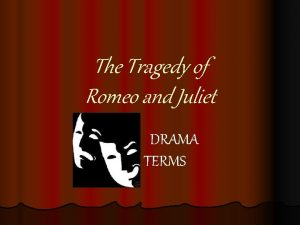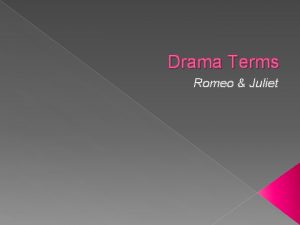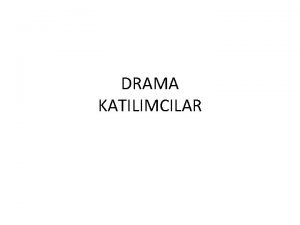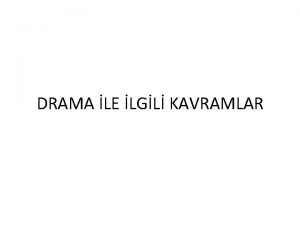Romeo Juliet Literary Terms Drama a story written



























- Slides: 27

Romeo & Juliet Literary Terms

Drama a story written to be performed by actors

Soliloquy a long speech expressing the thoughts of a character alone on stage

Monologue a speech by one character in a play, story, or poem l

Prologue an opening speech that introduces the play’s main characters, plot, and setting l

Tragedy l a work of literature, especially a play, that results in a catastrophe for the main character.

Tragic hero la character of noble birth with the potential for greatness, but due to a tragic flaw in his character makes an error in judgment that leads to his death

Aside a short speech delivered by an actor in a play traditionally directed at the audience. l

Comic Relief a technique that is used to interrupt a serious part of a literary work by introducing a humorous character or situation. l

Dialogue l a conversation between characters

Blank Verse lpoetry written in unrhymed iambic pentameter

Dramatic Foil la character that provides a contrast to another character – opposites

Suspense la feeling of uncertainty about the outcome of events in a story – a way to keep the reader interested

Dramatic Irony when a reader knows something that a character doesn’t know l

Pun l Shakespeare loved to use them. ¡Humorous use of a word with two meanings > sometimes missed by the reader because of Elizabethan language and sexual innuendo

Prose l. Ordinary writing that is not poetry, drama, or song ¡Only characters in the lower social classes speak this way in Shakespeare’s plays ¡Why do you suppose that is?

Sonnets l. A fourteen line lyric poem, usually written in rhymed iambic pentameter l Topics: ¡ Love ¡ Friendship ¡ Mortality ¡ Immortality of poetry

Iambic Pentameter A series of five stressed and unstressed syllables in a line of poetry l

Couplet la pair of rhyming lines in poetry

That completes our notes on literary terms. Now we will discuss sonnets more in depth.

Sonnets l. A sonnet consists of three quatrains and one couplet

Sonnets l. A quatrain is a series of four rhymed lines

Sonnets ¡First quatrain: the subject is revealed and why it is loved is explained ¡Second quatrain: describe what is special about the subject – be descriptive and imaginative ¡Third Quatrain: A problem arises with loving the subject

Sonnets l. A couplet is a series of two rhymed lines l Summarizes and leaves the reader with a new, concluding image

Sonnets l. Rhyme Scheme – a pattern of rhyme in a poem l. Sonnet Rhyme Scheme: ABAB/CDCD/EFEF/GG

Sonnets l. Iambic Pentameter: five beats of alternating unstressed and stressed syllables (“da. DUH”); ten syllables per line. Meter means rhythm.

Sonnets “Who’s wood / these are / I think / I know /his house” “Is in / the village / though he / will not / mind me / stopping”
 Figure of speech in romeo and juliet
Figure of speech in romeo and juliet Alliteration romeo and juliet
Alliteration romeo and juliet Literary terms in romeo and juliet
Literary terms in romeo and juliet A long uninterrupted speech by one character
A long uninterrupted speech by one character Romeo script
Romeo script Romeo ve juliet
Romeo ve juliet Drama literary terms
Drama literary terms Drama script example
Drama script example Romeo and juliet written
Romeo and juliet written Arthur brooke poem
Arthur brooke poem Romeo and juliet
Romeo and juliet Short story in literary terms
Short story in literary terms Character traits of lady montague
Character traits of lady montague Romeo poem
Romeo poem Important quotes from act 1 scene 5 romeo and juliet
Important quotes from act 1 scene 5 romeo and juliet Diction in romeo and juliet
Diction in romeo and juliet Wherefore art thou romeo meaning
Wherefore art thou romeo meaning Act 4 scene 4 romeo and juliet
Act 4 scene 4 romeo and juliet Romeo and juliet literary analysis
Romeo and juliet literary analysis Literary devices in romeo and juliet
Literary devices in romeo and juliet Examples of metaphors in romeo and juliet
Examples of metaphors in romeo and juliet Funny oxymorons
Funny oxymorons Long uninterrupted speech
Long uninterrupted speech Literary techniques in romeo and juliet
Literary techniques in romeo and juliet Willam shakespeare facts
Willam shakespeare facts Compare and contrast west side story and romeo and juliet
Compare and contrast west side story and romeo and juliet Romeo and juliet plot structure
Romeo and juliet plot structure Introduction about romeo and juliet
Introduction about romeo and juliet

